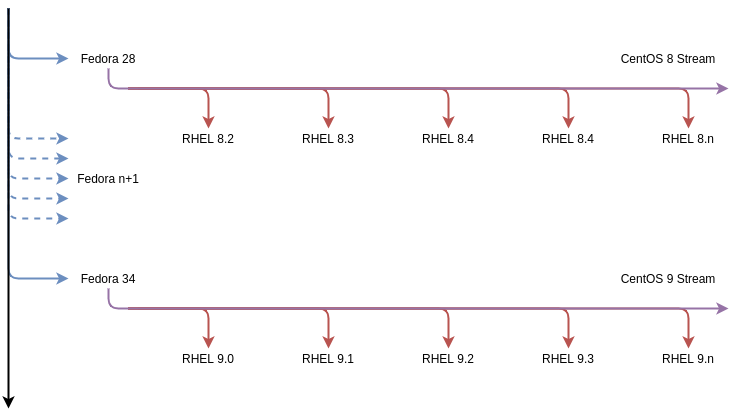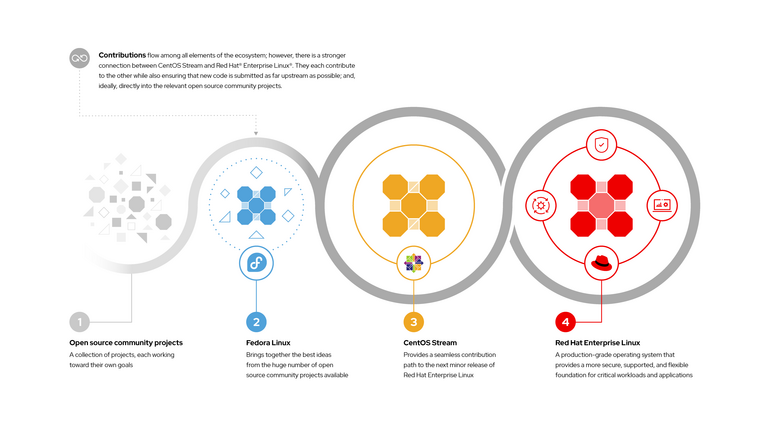Release - CentOS Stream 9
In November 2021, Red Hat Enterprise Linux 9 Beta was released and CentOS Stream 9 images were available. CentOS Stream 9 is officially released and the CentOS project announced this step in a small Blog article in December 2021. Let's see what's new and what has changed.

In November 2021, Red Hat Enterprise Linux 9 Beta was released and CentOS Stream 9 images were available. CentOS Stream 9 is officially released and the CentOS project announced this step in a small Blog article in December 2021.
Let's see what's new and what has changed. I am also giving a quick insight about CentOS Stream in general.
CentOS Stream
Before digging into the new features and benefits of CentOS Stream 9, let me give a brief gist of CentOS Stream in general. As you may be aware, CentOS Linux was deprecated and effectively ceased in December 2020. This happened, since the project wanted to focus on CentOS Stream.
In contrast to some opinions, CentOS Stream is not a rolling release distribution, comparable to Arch Linux. It is a constant stream of bug fixes and minor improvements, based on a major release. It is very unlikely to see breaking changes.
Furthermore, CentOS Stream is based on Fedora Linux and is the effective upstream of Red Hat Enterprise Linux. In a conservative world, it is an effective and constant preview of Red Hat Enterprise Linux. In a more DevOps way, it is the effective main/master-branch of Red Hat Enterprise Linux.

This allows a very nice way of partnering the distributions and provides a way to directly influence how RHEL will look like.

You can find more details about CentOS Stream, the history and intention in some articles like Spotlight - CentOS Stream and Future of CentOS. It may be also worth your time, checking out related articles.
Release & Support
Now, what is the new Release and Support plan? Yes, there will be support. You can now really contribute to CentOS via code contributions or bug reports and feature requests.
On the other hand, the lifetime of CentOS Stream is shorter than CentOS and is tightly coupled to the Red Hat Enterprise Linux Full Support Phase. This means, CentOS Stream 9 will be supported for ~5 years. During this time you will see bug fixes, security fixes, some hardware enablement and selected enhancements for software.
There is a huge difference in minor releases. There are none. Other than CentOS 8, you will not see any minor releases for CentOS Stream. Instead, you will get the above-mentioned patches in a constant stream. This can mean, there may be updates available on a daily basis.
General Changes
And what's changed now? First, there is a dedicated (yet very minimal) page for CentOS Stream 9.
CentOS Stream 9 is based on Fedora 34, but has not stopped the development there and includes some very recent software.
- Kernel 5.14
- GCC 11.2
- Python 3.9
- Perl 5.32
- Ruby 3.0
- OpenSSL 3.0.0
- OpenSSH 8.6p1
- GNOME 40
- default cgroups v2
This is a substantial jump from CentOS 8.5 / CentOS Stream 8.
Server Changes
There is also a pretty huge difference for servers. We will get some very recent software, including the below:
- PHP 8.0
- Node.js 16
- Apache httpd 2.4
- MariaDB 10.5
- MySQL 8.0
- PostgreSQL 13
- Nginx 1.20
At least the PHP and Node.js changes will have a big impact, if you want to migrate your workload from older CentOS Installations. But, you will see better performance and security, too.
How to get
Getting started with CentOS Stream 9 is pretty easy. Just browse to the download page and spin up a VM. There are also options to run CentOS Stream 9 in a container or at your cloud provider. If you just want to have a first look, you might try a container first.
# Start with Podman
$ podman run -it --rm quay.io/centos/centos:stream9 bash
# Start with Docker
$ docker run -it quay.io/centos/centos:stream9 bashUnfortunately, there is still no in-place upgrade option for CentOS major upgrades. If you want to upgrade your older machines, you need to re-install and migrate manually.
Docs & Links
Since CentOS Stream 9 and RHEL 9 are very tightly coupled, I strongly recommend reading additional articles, if you want to migrate.




Conclusion
During my first test drives, I was not able to use Secure Boot on my Intel NUC and this seems to be an issue with signing EFI SHIM, Grub and whatnot (really not a secure boot expert).
Nevertheless, the release feels very solid and the software is very recent. Additionally, you can use Podman (which was updated, too) to spin up containers and get even more recent software.
What I am still missing is a Fedora CoreOS / RHCOS alternative, built with CentOS. Not sure if this will come at some point. How do you feel about CentOS Stream 9? What do you love and what do you miss?







